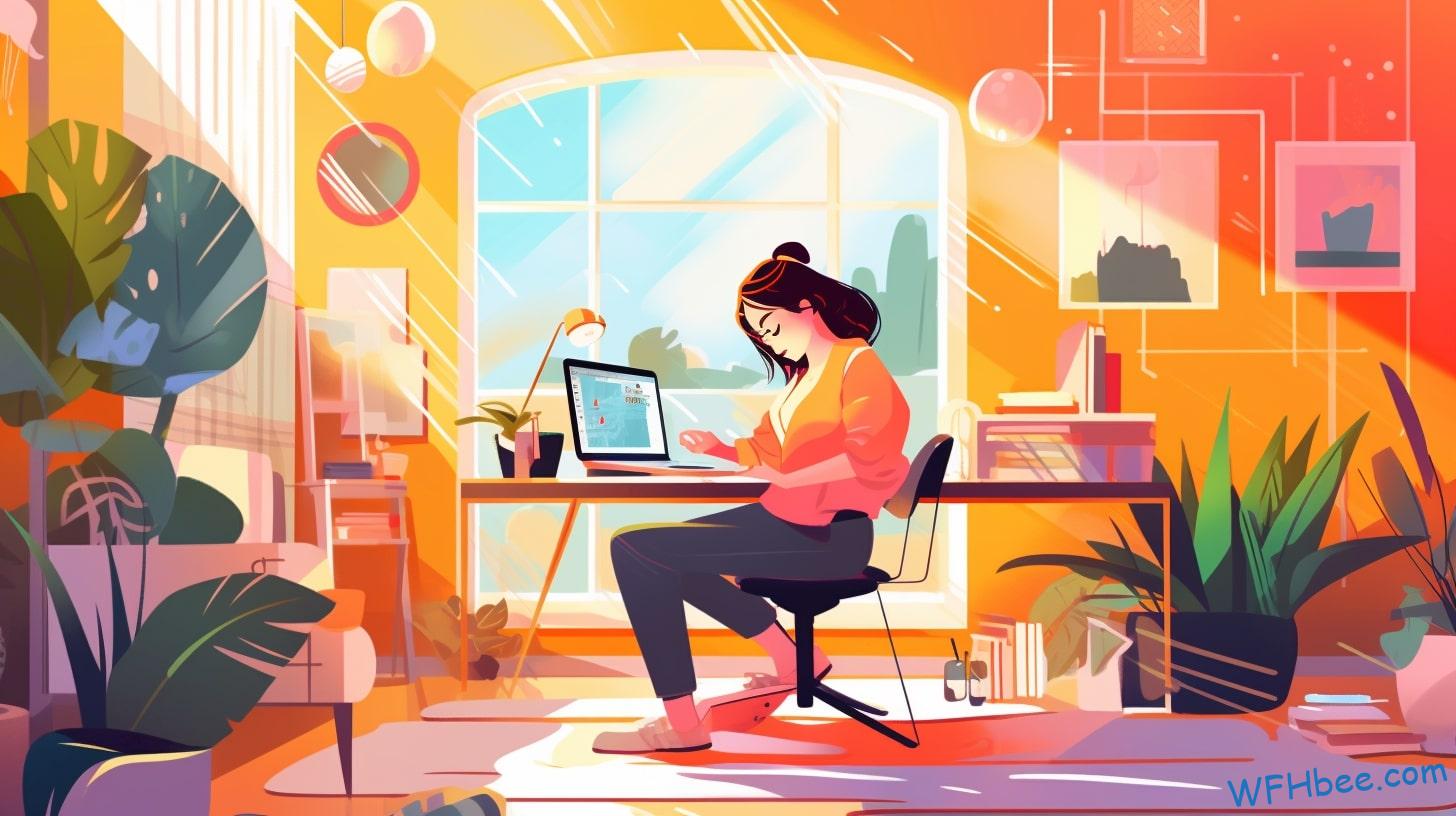Working from home has become the new normal for many of us during this time, but it can often be uncomfortable and difficult to adjust to. Finding ways to make our home office space more comfortable will help boost productivity and mental health. In this article, we’ll explore how you can create a cozy workspace that is conducive to getting work done.
Are you struggling with staying comfy when working from home? Do your neck and back hurt after long days spent at your desk? If so, it’s likely because your environment isn’t optimized for comfort. But don’t worry—there are plenty of simple things you can do to upgrade your home office setup and make it easier on yourself! From investing in ergonomic furniture to setting boundaries between work and leisure activities, there are lots of small changes that can make all the difference.
If you’re ready to take control of your workspace and enjoy the freedom that comes with working remotely, then read on! We’ll share some tips on how to transform your living space into an oasis of ultimate coziness — perfect for powering through those day-to-day tasks with ease.

We’ll go through the following topics in this article:
Table of Contents

Defining A Home Office Space
Setting up a home office is key to being comfortable while working remotely. Having an area specifically set aside for work will help you stay organized and focused, allowing you to get the most out of your remote job. To make sure your home-office space works best for you, it’s important to define it clearly by designing and laying it out properly.
When deciding how to design your home-office space, start with understanding what type of environment helps boost productivity. Consider factors like natural light, noise levels, temperature control, and seating comfort when picking furniture or décor that best fits the needs of your workspace. If necessary, invest in equipment such as ergonomic chairs or adjustable desks that are designed to keep workers healthy during long hours of sitting at a computer monitor.
Lastly, take advantage of any extra amenities like art pieces or plants that bring life into your new workspace setting. Visual stimulation can have positive effects on productivity so don’t hesitate to add items that appeal to your creativity and spark inspiration throughout the day. By taking these steps to create an inviting yet professional atmosphere within your home-office layout ideas, you can ensure success in achieving freedom from the workplace!
Ergonomic Furniture And Accessories
Now that you have a dedicated home office space, it is important to also make sure it has the right ergonomic furniture and accessories. Ergonomics are essential for your body’s health while working from home. Here are some items that will help make your work experience more comfortable:
- A good chair with adjustable height, seat depth and lumbar support;
- An adjustable desk so you can stand up or sit down at ease;
- Ergonomic computer peripherals like an ergonomic mouse and keyboard;
- Monitor stands and document holders for better posture when typing;
- Footrests if needed.
Investing in the proper equipment can greatly improve your productivity and comfort level in your workspace. It’s important to keep those wrists straight when typing, eyes level with the monitor, feet flat on the floor and back supported by an appropriate chair—all of which can be achieved through thoughtful purchases of ergonomic furniture and accessories. Furthermore, having these kinds of items in place not only makes you feel more productive but also gives you a sense of control over how you want to spend your day as well as freedom in expressing yourself within your personal workspace. For this reason, investing in quality ergonomic pieces pays off both mentally and physically!

Lighting Strategies
Having the right lighting in your home office can make a huge difference to how comfortable you feel when working from home. Whether it’s natural light or artificial, there are some key strategies and tips you can use to create a space that feels just as inviting as an office outside of your house.
Start with natural light: Taking advantage of natural light is one of the most powerful elements for creating a positive atmosphere in any room. If possible, try setting up near windows so that sunlight can fill the area throughout the day. This will help keep energy levels high and also reduce strain on eyesight due to bright screens. Plus, if you open curtains during work hours you can enjoy beautiful views which brings additional comfort into your workspace.
Choose appropriate lamps: The type of lamp used makes all the difference in terms of lighting design. Make sure they don’t cause glare on computer screens; opt instead for models that evenly distribute brightness across surfaces. Also consider adding adjustable-level floor or table lamps should you need more illumination at times when natural light isn’t available. Not only do these provide extra visibility but they add an element of warmth to the environment too.
Think about color temperature: One final thought relates to color temperature – this has been shown to affect mood and productivity levels depending on its hue (i.e., warm yellow tones versus cooler whites). While white lights might be easier on our vision, warmer colors have been known to foster creativity and relaxation while we work – something well worth considering!
No matter what kind of lighting solutions or ideas you decide upon, choosing carefully will ensure that working from home always remains an enjoyable experience – never compromising on quality or comfort for convenience’s sake!

Background Noise Reduction
The sound of silence is golden when working from home, but not always achievable. To help create a distraction-free workspace, noise reduction is essential to keeping your focus and productivity up. Here are some tips for creating a quieter space:
- Invest in soundproofing items such as rugs, curtains or acoustic foam tiles that absorb any background noise from outside sources.
- Add white noise machines or apps to mask out distracting sounds.
- Utilize noise-cancelling headphones to block out external distractions while you work.
- If possible, move the location of your workspace to an area with less traffic or activity happening nearby.
Creating a quiet environment can be difficult at times, but it’s worth the effort! Taking steps to reduce background noises will allow you to stay focused on what matters most—getting things done without interruption. With these simple solutions in place, you’ll soon find yourself enjoying a peaceful and productive day of working from home that much more!

Minimizing Distractions
Working from home can be a challenge if you don’t know how to stay focused and reduce distractions. It’s important to minimize any interruptions while working, so that you’re able to efficiently get your work done. Here are some tips for minimizing distractions while working from home:
First, try reducing the number of interruptions by turning off notifications on social media or email accounts. You should also avoid procrastination traps such as checking your phone every ten minutes or browsing through news articles. If possible, designate a specific area in your house where you will do all of your work; this way it’s easier to keep focus since there won’t be any temptations around you. Consider setting up an office space with comfortable furniture and adequate lighting, even if it just means arranging a desk in your bedroom or living room. This creates an environment conducive to productivity and allows you to separate yourself mentally from other activities happening at home.
It may also help to create boundaries between work time and leisure time; set blocks of times when you will fully dedicate yourself to completing tasks without allowing anything else into your day-to-day routine. To achieve this goal, make sure that family members understand the importance of respecting these designated periods by not disrupting them unless absolutely necessary. Additionally, consider using noise canceling headphones if conversations or background noise makes it hard for you concentrate on what needs doing throughout the day.
Finally, if you find yourself unmotivated working from home, remind yourself why you chose to take on remote employment in the first place — whether it was for freedom, flexibility or something else — and use that motivation as fuel for staying productive during those hours spent at home!

Establishing A Routine
Putting a plan in place is key to making working from home comfortable. Establishing a routine that works for you and fits within your lifestyle can go a long way towards helping you stay productive while enjoying the freedom of being at home. Here are some tips on how to develop an effective home office routine.
First off, set regular work hours that fit best with what you have going on throughout the day. This will help create structure and make it easier for you to stay focused during designated work time. Additionally, block out time for breaks—it could be something as simple as stepping away from your desk or taking a stroll outside—to clear your mind and give yourself needed downtime.
Another important part of creating an effective routine is setting achievable goals each day and breaking them down into small tasks so they’re manageable and not overwhelming. Writing down these goals is also helpful because then you can easily track your progress over time and keep yourself motivated along the way. Finally, don’t forget about self-care! Taking care of both your mental and physical health should always remain top priorities no matter where or when you’re working.
By implementing these steps into your everyday life, you’ll soon find yourself settling into an efficient rhythm that allows you to take advantage of all the benefits of working from home without feeling overwhelmed by stress or anxiety.

Setting Boundaries With Family And Friends
Setting boundaries when working from home can be challenging, especially if you have family and friends around you. It’s essential to manage your time properly in order to stay productive while also being comfortable at home. Here are some tips on setting boundaries with family and friends:
-Communicate clearly that you need uninterrupted work periods during the day. Explain why it is important for your mental health and productivity levels.
-Set up specific hours where family members or friends know not to disturb you so that you can focus without distraction.
-Schedule breaks during the day for socializing and catching up with family or friends. This will help give them a sense of normality instead of feeling like they’re constantly intruding on your workspace.
-Ensure everyone understands the importance of respecting each other’s space, particularly when it comes to sharing common areas such as kitchens or living rooms.
Working from home doesn’t have to mean sacrificing comfort or happiness—it just means finding new ways to balance both worlds effectively. With proper communication and clear expectations set out beforehand, everyone involved should understand their roles more easily and find a way to coexist peacefully under one roof!

Making Time For Breaks
As we transition from the previous section about setting boundaries with family and friends to this one about making time for breaks, it’s important to recognize that comfort is a multi-faceted concept. It’s like an onion; there are many layers of things you can do to make working from home more comfortable. One layer in particular is taking regular breaks throughout the day. Taking lunch or other types of break time not only helps us unwind but also gives us a chance to refresh our minds so that we can be productive and creative when we return to work.
When it comes to how often you should take breaks and what kind of break activities you should engage in, everyone has their own preferences. Some people prefer several short breaks throughout the day while others prefer fewer but longer ones such as a full hour for lunch. Ultimately, it depends on your individual needs and lifestyle, so experiment with different combinations until you find something that works best for you.
If possible, try to get away from your desk during your break times too by doing some physical activity outdoors or going somewhere else in the house where you won’t be distracted. This will help create mental distance between yourself and work which is essential if you want those precious few minutes off feeling restorative rather than just another thing on your busy agenda – after all, freedom begins within!

stretching-exercises">Stretching Exercises
Working from home can be a great way to get things done, but it can also lead to physical discomfort. Stretching exercises are one of the best ways to alleviate this and make working from home more comfortable.
These exercises help relieve tension in various parts of the body that accumulate throughout the day – especially if you’re sitting at a desk for extended periods of time. Back stretches, neck stretches, arm stretches, and leg stretches are all effective stretching exercises that have been proven to reduce pain.
Before beginning any type of exercise routine, it’s important to warm up your muscles first by doing some light movements like marching in place or taking a few minutes to go over basic stretches. Doing some simple backbends is also helpful as they will loosen up tight areas around your spine. Additionally, try incorporating shoulder rolls into your daily schedule – these can help improve circulation which is essential when dealing with tiredness or joint stiffness.
To top off your stretching routine, adding yoga poses and deep breathing techniques can help relax both mind and body while providing additional benefits like improved balance and coordination. Remember not to push yourself too hard during exercising; take breaks throughout the day so you don’t overexert yourself or aggravate existing conditions. Taking care of our bodies should always be priority number one!

Healthy Eating Habits
Just like any other job, working from home requires us to take care of ourselves. Eating healthy can help us stay productive and focused while we’re at our desks. We should think of it as a form of self-care that can benefit both our physical and mental health.
Nutritional meal planning is key when it comes to eating healthy while working from home. Taking the time to plan meals ahead of time ensures that you have the right ingredients in your fridge or pantry for nutritious meals throughout the week. It also helps with portion control – something that’s easy to overlook when cooking one’s own food! To make things simpler, try breaking each day into sections: breakfast, lunch, dinner, and snacks. This will ensure you don’t forget about anything important.
Healthy snack options are also great for keeping energy levels up during long work days at home. Fruits and vegetables are always a good option since they provide essential nutrients needed for optimal productivity. Nuts, yogurt, granola bars and smoothies are all tasty alternatives if you’re looking for something more filling than fruit or veggies alone. Additionally, these snacks don’t require too much prep work so you won’t be wasting precious hours prepping food instead of completing tasks on your to-do list!
Working from home poses unique challenges but by making sure you keep yourself nourished with healthy foods you’ll be able to remain alert and productive without sacrificing your overall wellbeing! With just a few simple tips and tricks you can easily maintain balanced nutrition routines while staying stress-free and content in the comfort of your own home office space.

Creating An Inspiring Environment
Creating an inspiring environment to work from home is essential for both mental clarity and productivity. Redecorating your space can be a great way to foster creativity and provide the perfect atmosphere to get things done. Investing in some home decor, such as artwork or plants, will give you a sense of purpose during those tough days when it may feel like you’re stuck in limbo.
Having a designated area specifically to work from also helps create structure that’s necessary if you want to stay productive while working remotely. Whether it be an extra bedroom or simply carving out a corner of the living room, having a creative space set aside for yourself can make all the difference in staying focused on the task at hand.
It’s equally important not only to carve out physical spaces but digital ones as well. It can be helpful to have different applications open depending on what type of project you are tackling so that everything is organized in one place. This way, switching between tasks won’t require too much time spent searching through folders and files. With these few tips combined with strong motivation and discipline, anyone can turn their home into an ideal workspace where they can thrive.

Investing In Technology Tools
The move to working from home is a great opportunity for businesses and their employees – but it also comes with some challenges. To make the most of this transition, investing in technology tools is essential. By providing employees with access to the right tech resources, you can ensure that they stay productive and connected while away from the office. Here are some key investments to consider:
- Computer: A reliable laptop computer or desktop PC will enable your team to work efficiently from any location. Ideally, these should be equipped with all necessary software programs – such as word processing applications and project management systems.
- Video Conferencing: Investing in video conferencing platforms like Zoom or Skype enables remote teams to communicate quickly and effectively over long distances. This makes it easy to hold virtual meetings, share ideas, and collaborate on projects without having everyone physically present at once.
- Cloud Storage & Document Sharing: File sharing services like Google Drive give teams access to shared documents anytime, anywhere. With cloud storage solutions, companies can make sure that important files are always up-to-date and easily accessible no matter where each employee is located.
By making smart investments in technology tools like these, employers can help create an environment which allows remote workers to stay productive – while still enjoying the freedom of being able to work outside of the traditional office setting!

Connecting With Co-Workers And Colleagues
Creating meaningful connections with coworkers and colleagues is essential in the remote work environment. It can be challenging to establish relationships when working from home, but it doesn’t have to be an insurmountable task. There are several ways to keep connected while adhering to social distancing protocols.
Virtual team meetings allow for real-time collaboration without any physical contact. Online conferencing tools like Zoom or Skype provide a convenient platform for engaging conversations and brainstorming sessions. Video calls make it easy to connect with people face-to-face while still being apart. Team building activities such as icebreakers and group challenges serve to strengthen bonds within the organization.
Finding creative solutions helps facilitate better communication and connection among remote teams. Setting up virtual coffee breaks, online game nights, or even digital happy hours gives everyone an opportunity to interact beyond their regular duties. Creating forums where employees can share ideas, ask questions, get advice, and discuss successes help foster engagement across the entire team – no matter how far apart they may physically be.
The key is to create a safe place where everyone feels comfortable expressing themselves freely. By taking advantage of all these different methods of keeping in touch, you can ensure that your remote workers remain connected despite not being able to meet in person.

Utilizing Online Resources
Working from home can be a challenge. But the right online resources can make it more comfortable and productive for remote workers. Online learning is an excellent way to keep up with education, training, or new skills from your own home. There are many free or low-cost classes available that you can take advantage of while working remotely.
Virtual meetings are also essential when working from home. You don’t have to miss out on important conversations or decisions just because you’re not in the office. Video conferencing platforms like Zoom, Skype, and Google Hangouts allow remote teams to communicate easily without leaving their homes. Remote collaboration tools like Slack and Microsoft Teams help people work together efficiently even if they aren’t in the same workspace.
Remote working doesn’t have to feel isolating – there are plenty of ways to stay connected with others while still being able to do your job at home effectively. Utilizing these online resources can help make this transition easier so that you can get back into a productive routine no matter where you choose to work from!

Prioritizing Self-Care
Working from home can be a difficult transition to make, and while it may provide flexibility and freedom, there are still some mental health issues that come with this shift. It is important to prioritize self-care in order to remain productive and comfortable while working remotely. Here are five strategies to find balance:
- Incorporate mindfulness practices into your daily routine: Mindfulness can help you stay focused on the task at hand by providing an opportunity for reflection and relaxation. Whether through meditation, journaling or even just taking deep breaths throughout the day, incorporating mindful moments will help maintain a healthy work/life balance.
- Create boundaries between work and personal life: Working from home can blur the lines of what time is “me” time versus “work” time. To combat this, set specific hours where you only focus on one or the other. This ensures that both aspects of your life have dedicated attention without sacrificing either one completely.
- Develop self-care strategies tailored to your needs: Everyone has different ways of finding comfort when under stress. Whether it’s indulging in a favorite hobby or going for a walk during lunchtime, implementing small acts of self-care can go a long way towards maintaining good mental health as well as productivity levels while working remotely.
- Make use of relaxation techniques such as breathing exercises: Taking breaks throughout the day allows our brains to reset and recharge so we can continue being productive over extended periods of time. Simple breathing exercises like 4-7-8 breath counting (inhale for four seconds, hold for seven seconds, exhale eight seconds) are great tools to keep yourself relaxed during those times when things start getting overwhelming.
- Take advantage of online resources if needed: If feelings of anxiety or depression become too much then don’t hesitate to reach out for support from friends or professionals who specialize in helping people cope with these types of issues. There are many free resources available online such as apps that offer guided meditations or articles about how best manage difficult emotions related to remote working setups – take advantage of them!
Whether it’s something simple like making sure you get enough rest each night or more complex activities like engaging in mindful moments throughout the day, prioritizing self-care should always be top priority when working from home – not just because it helps us stay creative and productive but also because it keeps us feeling mentally healthy and happy overall!crea

Conclusion
The transition from office to home can be difficult, but with a few simple adjustments and some thoughtful planning, you can create an environment that’s comfortable and conducive for productivity. By defining a designated workspace, investing in ergonomic furniture and accessories, utilizing background noise reduction strategies, minimizing distractions and leveraging technology tools, you can ensure your work-from-home experience is as productive—and enjoyable—as possible.
But don’t forget about self-care! Working from home may offer more flexibility than the typical 9–5 job, but it also requires discipline. Make sure to take regular breaks throughout the day so that you stay focused and energized. Lastly, reach out to co-workers or colleagues via video chat or other digital platforms; connecting with others virtually will help keep morale high when working remotely.
Overall, working from home requires dedication and creativity in order to remain motivated while feeling connected to your team. With mindful effort you can achieve comfortability while staying productive – allowing yourself to better enjoy the benefits of remote work!
Author: Robin Borg
Hi, I’m Robin. I have been working from home at least one day a week during all of my adult life. I have a background in research and data science. Get to know me better in the About page.







